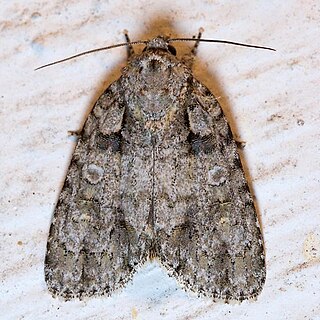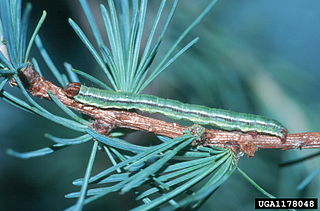
Acronicta increta, the raspberry bud dagger moth, raspberry bud moth or peach sword stripe night moth, is a moth of the family Noctuidae. The species was first described by Herbert Knowles Morrison in 1875. It is distributed throughout the south of Canada and the United States down to Florida and Texas.

Bulia is a genus of moths in the family Erebidae.

Homophoberia is a genus of moths of the family Noctuidae. The genus was erected by Herbert Knowles Morrison in 1875.
Melanomma auricinctaria, the gold-lined melanomma moth, is the only species in the monotypic moth genus Melanomma of the family Erebidae. It is found in the United States and Canada. Both the genus and species were first described by Augustus Radcliffe Grote in 1875.
Anterastria teratophora, the grey marvel, is a moth of the family Noctuidae. The species was first described by Gottlieb August Wilhelm Herrich-Schäffer in 1854. It is found in North America from Quebec west to central Alberta, south to Florida and Arizona.
Capsula laeta, the red sedge borer, is a moth of the family Noctuidae. The species was first described by Herbert Knowles Morrison in 1875. It is found in North America, including Ohio, Illinois, New Jersey and Ontario.
Bulia similaris is a species of moth of the family Erebidae. It is found from southern California south to Baja California, east to southern Arizona, northwestern Sonora, western Texas and eastern Mexico.
Bulia schausi is a moth of the family Erebidae. It is found in north-western Mexico, with strays as far north as Arizona, though it was first found in Tehuacan, Mexico.

Bulia confirmans is a moth of the family Erebidae. It is found in Cuba, Jamaica, Haiti, the Dominican Republic, Puerto Rico, Grenada, northern Venezuela and Colombia.

Caenurgina annexa, the banded grass moth, is a moth of the family Erebidae. The species was described by Henry Edwards in 1890. It is found in western North America from western Alberta and Montana to British Columbia, Washington, and Oregon.

Caenurgina erechtea, the forage looper or common grass moth, is a moth of the family Erebidae. The species was first described by Pieter Cramer in 1780. It is found from coast to coast in the United States and adjacent parts of Canada. It is not found in Newfoundland, New Brunswick, Prince Edward Island, Yukon, or the Northwest Territories. The wingspan is 30–42 mm. Adults are on wing from March to November depending on the location.
Caradrina meralis, the rare sand Quaker, is a moth of the family Noctuidae. The species was first described by Herbert Knowles Morrison in 1875. It is found in North America from New Jersey and New Hampshire, Ontario, Ohio and Wisconsin west across southern Canada to British Columbia, south to California and Arizona.

Schinia lucens, the leadplant flower moth or false indigo flower moth, is a moth of the family Noctuidae. The species was first described by Herbert Knowles Morrison in 1875. It is found in the central and western United States.

Drasteria adumbrata, the shadowy arches, is a moth of the family Erebidae. The species was first described by Hans Hermann Behr in 1870. It is found from coast to coast in southern Canada, south in the west to California and Colorado, south in the east to New England and Michigan. Subspecies D. a. alleni is found from eastern Alberta to New York and Nova Scotia. Subspecies D. a. saxea occurs from southern British Columbia and south-west Alberta south to California and Colorado.
Drasteria perplexa, the perplexing or perplexed arches, is a moth of the family Erebidae. The species was first described by Henry Edwards in 1884. It is found in North America from Alberta and Saskatchewan south to Colorado and Arizona.
Drasteria ingeniculata is a moth of the family Erebidae. It is found in south-central United States.

Xestia dilucida, the dull reddish dart or reddish heath dart, is a moth of the family Noctuidae. The species was first described by Herbert Knowles Morrison in 1875. It is found in the United States from southern Maine to northern Florida, west to central Ohio and eastern Texas.

Eutricopis nexilis, the white-spotted midget, is a moth of the family Noctuidae. The species was first described by Herbert Knowles Morrison in 1875. It is found in North America from Nova Scotia and New England west across southern Canada to southern Vancouver Island, north to Yukon and south in the mountains to California and Colorado.

Macaria oweni, Owen's larch looper or Owen's angle moth, is a moth of the family Geometridae. The species was first described by Louis W. Swett in 1907. It is found in North America from Newfoundland to west-central Alberta, south in the east to northern New England.










